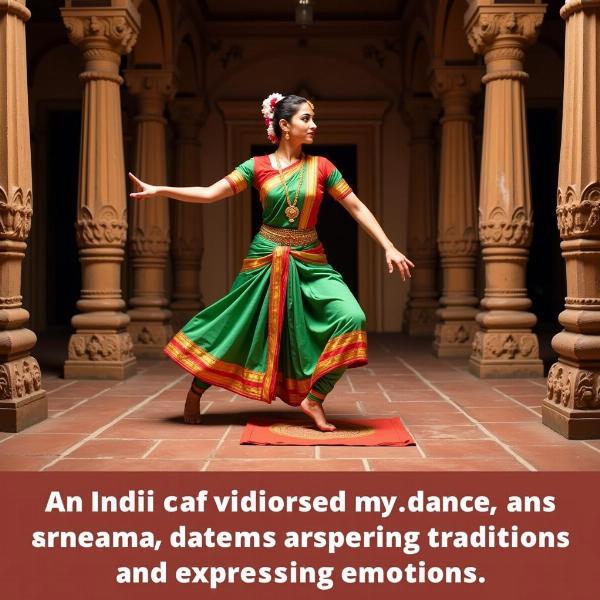Understanding “what a dance meaning in Hindi” goes beyond a simple translation. It delves into the rich cultural tapestry of India, where dance, or nritya, is an integral part of life, woven into traditions, rituals, and storytelling. “Dance” in Hindi isn’t just a physical act; it’s an expression of emotions, a form of devotion, and a celebration of life itself. This exploration will uncover the various nuances of dance in the Hindi context, from classical forms to folk traditions, and its significance in Indian society.
Unraveling the Hindi Word for Dance: Nritya and Beyond
The most common Hindi word for dance is nritya (नृत्य). It encompasses more than just rhythmic movement; it implies a holistic art form, combining expression, music, and storytelling. However, other terms also exist, each with its own subtle meaning. Nartan (नर्तन) often refers to pure dance, focusing on the technical aspects of movement and rhythm. Natya (नाट्य) encompasses a broader theatrical performance, incorporating dance, drama, and music. Understanding these different terms provides a deeper appreciation of the diverse world of Indian dance.
Classical Dance Forms: A Legacy of Grace and Devotion
India boasts eight classical dance forms, each with its unique style, costumes, and narratives. Bharatanatyam from Tamil Nadu, Kathak from North India, Kuchipudi from Andhra Pradesh, Odissi from Odisha, Mohiniyattam from Kerala, Manipuri from Manipur, Kathakali from Kerala, and Sattriya from Assam, are all recognized for their intricate movements, expressive storytelling, and deep spiritual connection. These forms are often performed in temples and during religious festivals, highlighting the intertwining of dance and devotion in Indian culture.
Folk Dances: Celebrating Life’s Rhythms
Beyond the classical traditions, India is vibrant with folk dances, reflecting the diversity of its regions and communities. Bhangra from Punjab, Garba from Gujarat, Bihu from Assam, and countless others celebrate harvests, weddings, and various aspects of daily life. These dances are often simpler and more accessible than classical forms, allowing community participation and fostering a sense of shared identity.
What Does Dance Symbolize in Indian Culture?
Dance in India transcends mere entertainment; it holds deep symbolic meaning. It’s a form of prayer, a way to connect with the divine, and a powerful medium for storytelling. The graceful movements, expressive gestures, and vibrant costumes often narrate mythological tales, historical events, and social messages. Dance also plays a vital role in social gatherings, weddings, and festivals, adding color and joy to these celebrations.
What is the cultural significance of dance in India?
Dance is deeply embedded in Indian culture, serving as a powerful medium for expressing emotions, storytelling, and preserving traditions. It’s not merely a form of entertainment but a way of life, reflecting the country’s rich heritage and spiritual beliefs. From ancient temples to modern stages, dance continues to play a central role in Indian society.
 Cultural Significance of Dance in India
Cultural Significance of Dance in India
Conclusion: More Than Just Movement
Understanding “what a dance meaning in Hindi” requires appreciating the multifaceted nature of nritya in Indian culture. It’s an art form, a spiritual practice, a social activity, and a powerful means of expression. Whether it’s the intricate beauty of classical forms or the vibrant energy of folk dances, nritya continues to enrich the lives of millions, reflecting the soul of India.
FAQ:
- What is the main difference between Nritya and Nartan? Nritya emphasizes expression and storytelling, while Nartan focuses on the technical aspects of dance.
- Which are the eight classical dances of India? Bharatanatyam, Kathak, Kuchipudi, Odissi, Mohiniyattam, Manipuri, Kathakali, and Sattriya.
- What is the role of dance in Indian festivals? Dance is an integral part of many Indian festivals, adding color, joy, and spiritual significance to the celebrations.
- Where can I learn more about Indian dance? Numerous resources, including books, online platforms, and dance schools, offer opportunities to explore the world of Indian dance.
- Why is dance considered a form of devotion in India? Many Indian dances are dedicated to deities and performed in temples, expressing devotion and connecting with the divine.
- What is the significance of hand gestures (mudras) in Indian dance? Mudras are symbolic hand gestures that convey specific meanings and enhance the storytelling aspect of Indian dance.
- How does Indian folk dance reflect the country’s diversity? Each region and community in India has its unique folk dances, reflecting local traditions, customs, and celebrations.
Related Articles:
- what is the hindi meaning of abundance
- yeast meaning in hindi pic
- greeny meaning in hindi
- kept on meaning in hindi
Meaning-Hindi.in is your premier destination for professional Hindi translation services. We offer a comprehensive range of solutions, from business and legal document translation to website localization and technical manual translation. Our team of expert linguists ensures accuracy and cultural sensitivity in every project. Whether you need fast turnaround times or specialized industry expertise, Meaning-Hindi.in can meet your needs. Contact us today for a free quote at [email protected] or call us at +91 11-4502-7584. Let us bridge the language gap for you.